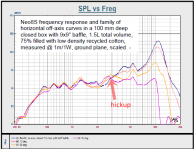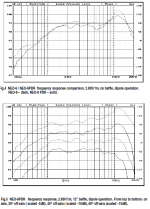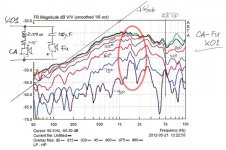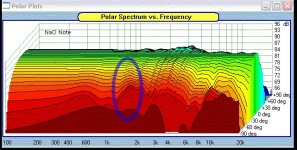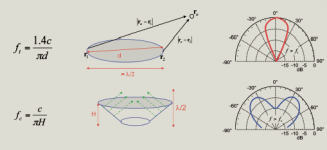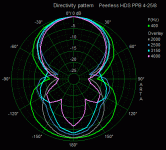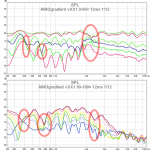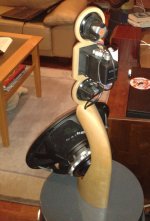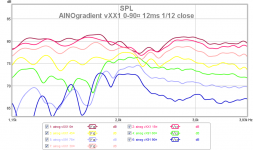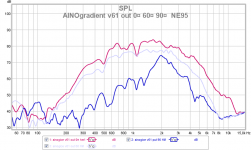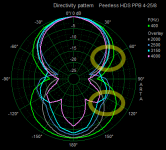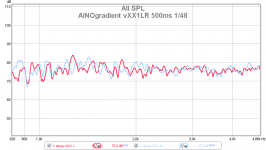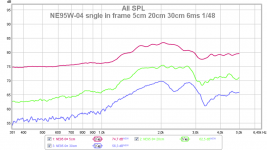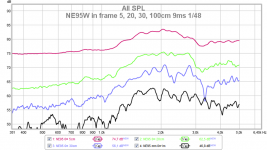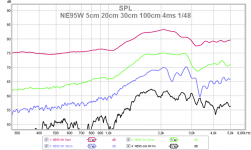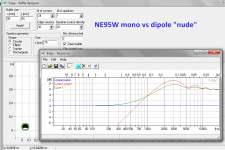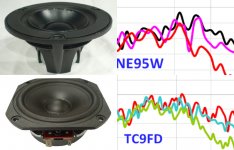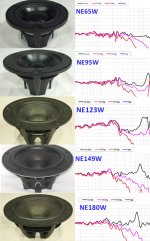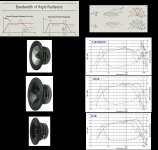Generally, a loudspeaker's membrane type detemines it's dispersion characteristics, we can group them in four categories
- pistonic/planar - medium width and even radiation
- conical - medium/narrowing at high F, (diameter and cone height determined, blooming at certain F)
- dome - wide and even
- horn - narrow and even
Options for planar/pistonic drivers are:
- AMT/ACT/ribbon drivers
- planar (or very flat cone) sandwich or ceramic membrane voice coil drivers (Accuton C90, TangBand etc.)
The problem with the later is that their magnet sructure makes large obstruction backwards, blocking the dipolic rear radiation. The price of these is also high. This is why I ended up with Neo8-PDR - a rectangular planar. It overrides both conical and circular problems!
Tangband W4-1798S
Accuton C90
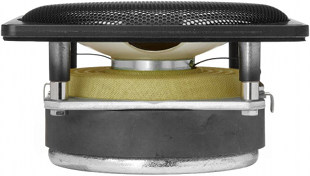
B&G Neo8-PDR
- pistonic/planar - medium width and even radiation
- conical - medium/narrowing at high F, (diameter and cone height determined, blooming at certain F)
- dome - wide and even
- horn - narrow and even
Options for planar/pistonic drivers are:
- AMT/ACT/ribbon drivers
- planar (or very flat cone) sandwich or ceramic membrane voice coil drivers (Accuton C90, TangBand etc.)
The problem with the later is that their magnet sructure makes large obstruction backwards, blocking the dipolic rear radiation. The price of these is also high. This is why I ended up with Neo8-PDR - a rectangular planar. It overrides both conical and circular problems!
Tangband W4-1798S
An externally hosted image should be here but it was not working when we last tested it.
Accuton C90

B&G Neo8-PDR
An externally hosted image should be here but it was not working when we last tested it.
Last edited:
I asked my pocket calculator again. You are right with the 4". The blooming happens about an octave below the expected dipole null. I don't have an explanation. If it would be my project, I would make 15° step polar measurements of the unequalized driver without the frame and start from there.Rudolf,
my 12" nudie has this blooming at 5-600, dipole null at 1300Hz
my 4" nudie has this blooming at 2kHz, dipole null at 4kHz
The behaviour is similar to dipole null blooming, yes. 'These appear below the dipole peak!
For the 12" driver I don't see real blooming at 5-600 Hz yet. The 60° curve keeps perfectly constant distance to the 0° curve. The 90° measurement isn't steady enough for my taste to make valid conclusions from it.
Rudolf
^partially so. The diameter (w x h) determines some characteristics, but not everything, cone depth is also important! Did you read the Klippel sheet? I have seen Neo8 and Neo3 horizontal dispersions and the Neo8 has "directivity blooming" at 7-8kHz (some hickup at 4kHz), Neo3 at 13-15kHz This is not a problem for me because I won't run Neo8 that high and don't want to use Neo3 as tweeter! Patricks dipole 0-45¤ was ok for me
The Neo8 will only replace double Peerless NE95W-04s. Fountek NeoCD3.5H will remain, I don't want dipole tweeter or dipole bass now!
I have already ordered Audax HM100s for testing, it has a square frame but conventional circular cone profile. I will test/measure it too and tell what I get!
Circular cones are widely used and well known generally but this directivity hick-up disturbs me, it is so prominent in my measuremnts. I have tried to overcome it by lowering xo, but then I loose dipole behaviour too early.
With Neo8 I suppose I will get these benefits/properties:
- it radiates as a pure dipole, no obstrucions, shallow frame
- remain high vertical directivity (it membrane is 170mm tall)
- get dipole null around 5kHz because of narrowness 89mm frame, 30mm membrane
- can shift xo higher around 5kHz
- avoid circular cone-related directivity issues (blooming at the onset of directivity)
- low distortion, "fast transients"
The Neo8 will only replace double Peerless NE95W-04s. Fountek NeoCD3.5H will remain, I don't want dipole tweeter or dipole bass now!
I have already ordered Audax HM100s for testing, it has a square frame but conventional circular cone profile. I will test/measure it too and tell what I get!
Circular cones are widely used and well known generally but this directivity hick-up disturbs me, it is so prominent in my measuremnts. I have tried to overcome it by lowering xo, but then I loose dipole behaviour too early.
With Neo8 I suppose I will get these benefits/properties:
- it radiates as a pure dipole, no obstrucions, shallow frame
- remain high vertical directivity (it membrane is 170mm tall)
- get dipole null around 5kHz because of narrowness 89mm frame, 30mm membrane
- can shift xo higher around 5kHz
- avoid circular cone-related directivity issues (blooming at the onset of directivity)
- low distortion, "fast transients"
Attachments
Last edited:
This same directivity hickup around 2kHz can be seen also with LX521 and NaO Note - see attachments circled areas.
SL told me that he doesn't think that this ís a real problem - and and he is a wise man! But seems like I am obsessed with this... it strikes my eyes every time I look at my measurements
SL told me that he doesn't think that this ís a real problem - and and he is a wise man! But seems like I am obsessed with this... it strikes my eyes every time I look at my measurements

Attachments
Take care - not all blooms are equalThis same directivity hickup around 2kHz can be seen also with LX521 and NaO Note - see attachments circled areas.
There are situations where the bloom starts from 0° and those where blooming starts from 90°. They have different causes:
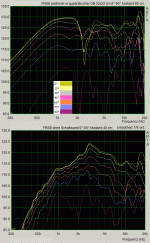
Both measurements are from the same Visaton FRS8 driver. It is centered in 22x22 cm OB in the upper diagram and measured without any baffle in the lower one.
The upper bloom at 2-3 kHz is typical of large baffles. It is heavy at 0-45° Hz and levels out for larger angles.
The lower bloom at 2-3 kHz is typical of backside irregularities reaching around the baffle edge to the front. You see it prominently in drivers measured without baffle. It gets less significant when baffles are added. It is most significant at 90-75° and less visible at smaller angles.
Rudolf
This same directivity hickup around 2kHz can be seen also with LX521 and NaO Note - see attachments circled areas.
SL told me that he doesn't think that this ís a real problem - and and he is a wise man! But seems like I am obsessed with this... it strikes my eyes every time I look at my measurements
Indeed, very interesting.
I was discussing that with Oliver Pirlich the other day. By chance I measured 3" Tangband semi-nude with no blooming to 10khz few yrs ago.
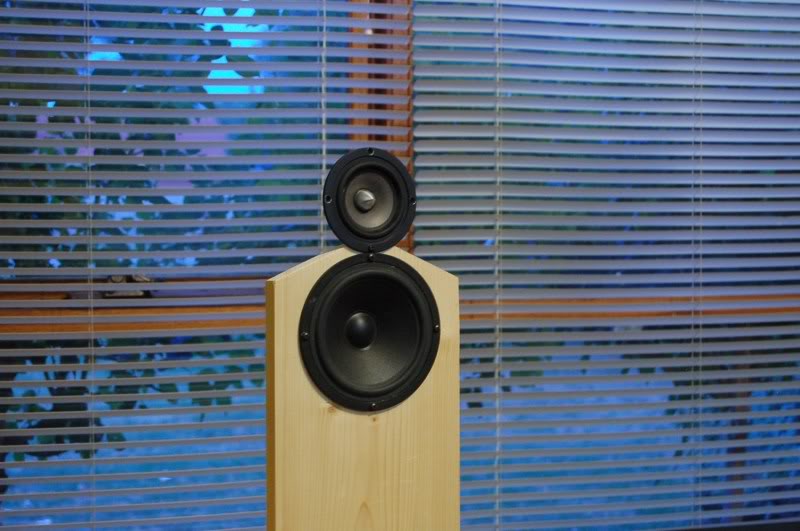
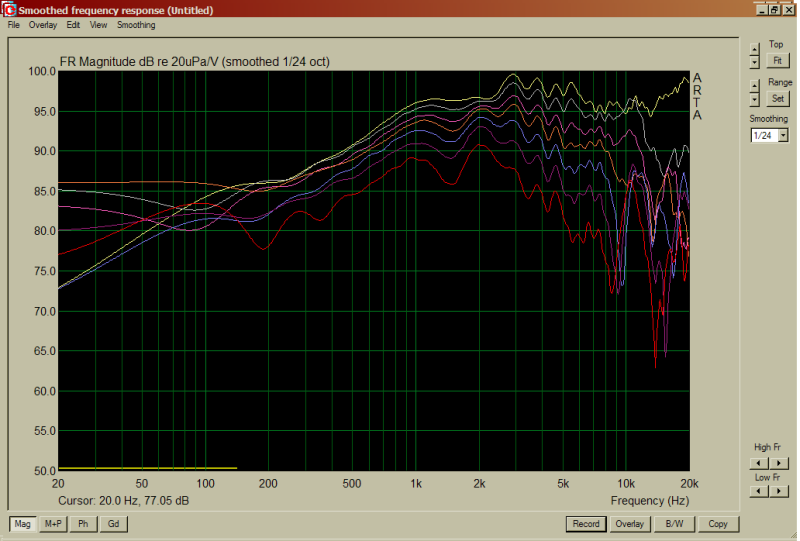
(actually I now wonder if that area at 2khz is a blooming!)
Would be interesting to see the driver inverted and the same measurements done.Indeed, very interesting.
I was discussing that with Oliver Pirlich the other day. By chance I measured 3" Tangband semi-nude with no blooming to 10khz few yrs ago.


(actually I now wonder if that area at 2khz is a blooming!)
Yes that's the typical 2kHz hickup of 4" cone drivers. Very "pure" because of less frame than my AINOs.
Ainos have MTM and I measured it yesterday with only one 4" playing. The response shows this problem better than my mtm! I am not at home, now so no attachments.
I haven't done backwards measurements of a single section playing. Rudolf has done tests from the backside and dispersion is pretty! Then the cone behaves more like a dome! However the response is much more ragged because of the magnet and casket/frame making diffractions
Please can someone make a calculation of this cone problem by using this formula by Klippel? I don't trust my maths!
Ainos have MTM and I measured it yesterday with only one 4" playing. The response shows this problem better than my mtm! I am not at home, now so no attachments.
I haven't done backwards measurements of a single section playing. Rudolf has done tests from the backside and dispersion is pretty! Then the cone behaves more like a dome! However the response is much more ragged because of the magnet and casket/frame making diffractions
Please can someone make a calculation of this cone problem by using this formula by Klippel? I don't trust my maths!
Attachments
Last edited:
0-90¤ and 90-180¤ of AINOgradient in closeups.
12ms 1/12 smoothing. Because indoor measurement has lots of reflections , it is very difficult to see what is really going on below 500Hz. Only one 4" dirver playing when measured 90-180¤. 90¤ is not same because driver is pointig at opposiste directions in these "runs"
AINOgradient is not symmetrical front-back because the 12" driver is tilted 30¤ and drivers have their magnets on the backside. Also, a cone is concave to the frontside and convex to the backside. The tweeter is monopole andis crossed LR4 at 3200Hz.
I have drawn circles around areas that show loss of dirctivity. Sorry I can't use ARTA and make those polar plots and sonograms.
12ms 1/12 smoothing. Because indoor measurement has lots of reflections , it is very difficult to see what is really going on below 500Hz. Only one 4" dirver playing when measured 90-180¤. 90¤ is not same because driver is pointig at opposiste directions in these "runs"
AINOgradient is not symmetrical front-back because the 12" driver is tilted 30¤ and drivers have their magnets on the backside. Also, a cone is concave to the frontside and convex to the backside. The tweeter is monopole andis crossed LR4 at 3200Hz.
I have drawn circles around areas that show loss of dirctivity. Sorry I can't use ARTA and make those polar plots and sonograms.
Attachments
Last edited:
I draw circles on Rudolf's polar map. Front and backside show discontinuity at 60¤!
Typical to cone drivers?
The question is - shall I put a peak correction to straighten my 2,5db on-axis dip or not? I have answered this NO lately. I tried to straighten it in many ways but it always had side effects.
Other question is - can we hear this deviation? I guess not. However 2kHz is a very sensitive to ears and if room response is blossoming, it can be sensed as hissing of highs! Room response measurements at 200 -500ms are not very sensitive to this because of FFT loses resolution with long gate. Listening to piano records and lady vocalists tells me to not eq this.
Typical to cone drivers?
The question is - shall I put a peak correction to straighten my 2,5db on-axis dip or not? I have answered this NO lately. I tried to straighten it in many ways but it always had side effects.
Other question is - can we hear this deviation? I guess not. However 2kHz is a very sensitive to ears and if room response is blossoming, it can be sensed as hissing of highs! Room response measurements at 200 -500ms are not very sensitive to this because of FFT loses resolution with long gate. Listening to piano records and lady vocalists tells me to not eq this.
Attachments
Last edited:
This might be new to some people too...
The effect of acoustic summation of various factors with increasing distance to microphone in nearfield
I made this series a month ago to study this 2kHz thing. A single driver playing. The frame is w=95mm, cone d=75mm, cone depth h=16mm Frame h at edges is 12mm, chamfering at backside of driver opening
6ms and 9ms IR gating
At 5cm it acts like a piston/plane with "baffle step" due to frame w
At 20cm we start to see dipole effect (frame w) and also the some dipping at 2kHz (cone h)
At 30cm we see full dipole behaviour and the on-axis dip formation at 2-2,2kHz due to cone (?)
At 1m we see smoothing/dilution of all this. with shorter gate 2,2kHz dip can be seen better.
The effect of acoustic summation of various factors with increasing distance to microphone in nearfield
I made this series a month ago to study this 2kHz thing. A single driver playing. The frame is w=95mm, cone d=75mm, cone depth h=16mm Frame h at edges is 12mm, chamfering at backside of driver opening
6ms and 9ms IR gating
At 5cm it acts like a piston/plane with "baffle step" due to frame w
At 20cm we start to see dipole effect (frame w) and also the some dipping at 2kHz (cone h)
At 30cm we see full dipole behaviour and the on-axis dip formation at 2-2,2kHz due to cone (?)
At 1m we see smoothing/dilution of all this. with shorter gate 2,2kHz dip can be seen better.
Attachments
Last edited:
4ms gating, otherwise same as previous
And Edge simulation of NE95W nude as monopole and as dipole.
- notice the 1,2kHz region compared to nearfield!!!
And Edge simulation of NE95W nude as monopole and as dipole.
- notice the 1,2kHz region compared to nearfield!!!
Attachments
Last edited:
gainphile - I find this very fun and interesting and as a personal challege. I set this question myself! Hopefully I have also "IR"L and a completely different profession, to maintain sanity! My family is the one who is going crazy with this, the measuring sweeps actually
Rudolf made this battleship (or missile?) from my v61 outdoor measurements (normalized) that really hit me in the eye No, I don't see any erotism in this!
No, I don't see any erotism in this!
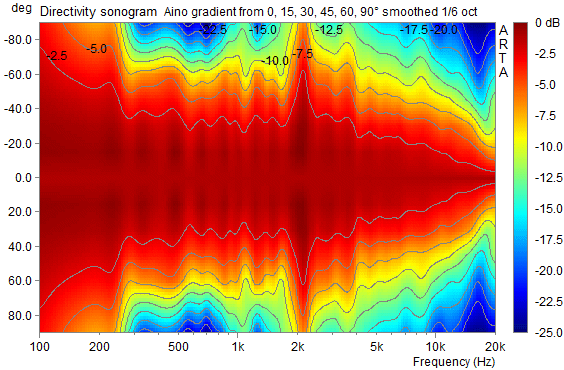
Rudolf made this battleship (or missile?) from my v61 outdoor measurements (normalized) that really hit me in the eye
 No, I don't see any erotism in this!
No, I don't see any erotism in this!
Last edited:
Here we can see how different two 80-90mm cone speakers can be. Both are from Tymphany because the company shows 0¤ 30¤ and 60¤ curves of every driver they make! Drivers are measured in IEC standard baffles. The dimensions vary according to driver membrane diameter.
Here we see the difference that comes from many factors
- cone profile and plug
- cone material
- surround type
I have clipped a closeups from 1-kHz and a photos from the Tymphany datasheets
The second collashe shows some of the NE seris drivers.
Here we see the difference that comes from many factors
- cone profile and plug
- cone material
- surround type
I have clipped a closeups from 1-kHz and a photos from the Tymphany datasheets
The second collashe shows some of the NE seris drivers.
Attachments
Last edited:
Here is an example of how stiff and soft cones behave, from SEAS datasheets.
The disadvantage of soft cones is higher distortion at highs because of the flapping membrane.
L18 has aluminium cone and phase plug
CA18 has coated paper cone and standard dust cap
U18 is a modern compromise using fibre reinforced cone and phase plug. Some loans from Klippel presentation included.
The disadvantage of soft cones is higher distortion at highs because of the flapping membrane.
L18 has aluminium cone and phase plug
CA18 has coated paper cone and standard dust cap
U18 is a modern compromise using fibre reinforced cone and phase plug. Some loans from Klippel presentation included.
Attachments
Last edited:
- Home
- Loudspeakers
- Multi-Way
- Aino gradient - a collaborative speaker project
